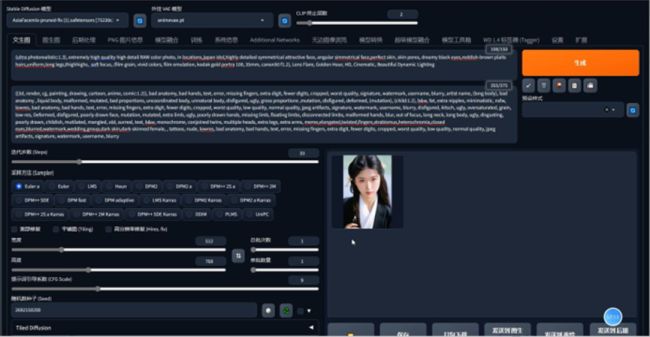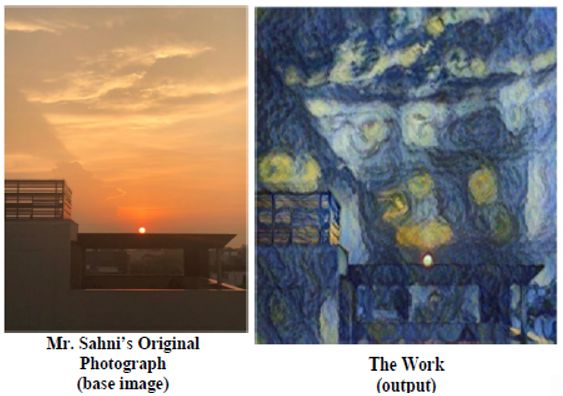1. Introduction: when PRC court encounters AIGC1
On November 27, 2023, the Beijing Internet Court made a judicial ruling on a case regarding the AI-generated images (the "First AI-image Case").2 This case is noted to be the first of its kind in China, involving a plaintiff surnamed Li and a defendant surnamed Liu. Li claimed that Liu used an image of a woman in her personal webpage without his permission in February 2023. Li mentioned that he had generated the image using Stable Diffusion, an open-source software and posted it on his own social media account at Xiaohongshu, a social media platform widely regarded as the Chinese version of Instagram.
Liu argued that she found the image by using a search engine and did not see any watermark or information about its copyright owner. She also said she was not using the image for commercial purposes. However, the Beijing Internet Court eventually ruled in favor of Li, pointing out that the image showed "intellectual achievements" by Li. The court said that Li had input keywords on the expectations of the image, such as the appearance and posture of the young woman, filter of the image, and even the lighting. Li had also invested in adjusting the draft images to get the ultimate image that he had chosen.

*Note: The above figure as a whole shows the operating interface of Stable Diffusion, and the image embedded displays the output generated.
2. Key analysis: AI-generated image regarded as work
According to the ruling and like other copyright infringement disputes, the main issues typically addressed include: (i) whether the picture in question constitutes a work under the Copyright Law of the People's Republic of China and what type of work it constitutes; (ii) whether the plaintiff owns the copyright on the disputed picture; and (iii) whether the defendant's behavior shall constitute an infringement. Compared to traditional copyright cases, particularly the ones occurring prior to the advent of artificial intelligence (the "AI") and Large Language Model (the "LLM"), two terms "intellectual achievements" and "originality" are intensively discussed in the ruling of the current case.
According to the ruling, the court defined the term "intellectual achievements" as the results of intellectual activities, which reflects the intellectual input of a natural person. Compared to the operating model and logic of the LLM at issue, the court emphasized the "intellectual investment" the plaintiff made in the disputed picture, demonstrating that designing the presentation of the character, selecting prompt words, arranging the order of prompt words, setting parameters, and selecting the intended picture shall all be regarded as the "intellectual investment".
With respect to the term "originality", the court stated that "to meet the 'originality' requirement, the work shall be completed independently by the creator, reflecting such creator's personalized expression."3 Historically speaking and even in the global legal landscape, the standard of "originality" is relatively low. In copyright cases, when pondering such subtle issue, it is commonly understood that the first of the two requirements encompassed by the term "originality" is independent creation and creativity. In the present case, the court claimed that "if (i) a work is completed based on a certain order, formula, or structure and (ii) different people would yield same results, the work does not have originality since the expression at issue is the only effective way of conveying a particular idea".4 Similarly, such principle already underlies the merger doctrine in the context of the western copyright system. According to the ruling of the present case, however, "when people use the Stable Diffusion model to generate images, diverse needs and expectations will be reflected in the picture once they specify and describe details of elements, layout, and compositions of the image".5 In this case, as the court finally determined that "there are identifiable distinctions between the picture in question and prior works".6 As a result, the court concluded that the work in question satisfied the requirement of originality.
It is also worth noting that the court forthrightly tied its ruling to a general policy argument, highlighting that the primary purpose of the copyright system is to encourage creation. Only if the copyright regime and legal methods could be properly applied, simulating more people to use the most up-to-date tools for creation process, more work will be cultivated, and the development of the AI technology will be enhanced. In addition, such policy analysis was heavily examined in the Research on Legal Feature and Copyright Attribution of AI-generated Images, where the presiding judge of the First AI-image Case continued to stress the competing considerations like the creator's rights and interests as well as the industrial development shall be balanced when making the judgement.7
3. Different angles: when "Originality" interpreted in another jurisdiction
By coincidence, the United States Copyright Office (the "USCO") tackled a seemingly identical case on December 11, 2023.8 Below are two figures respectively showing an original photograph taken by Mr. Sahni (i.e. the base image) and the Work titled "SURYAST" generated by an AI app (i.e. "RAGHAV Artificial Intelligence Painting App") (i.e. the output of AI) involved in this case. The Work, not hard to perceive, was derived from the style image (Vincent van Gogh's The Starry Night).

In this case, the USCO refused to register the Work because it "lack[ed] the human authorship necessary to support a copyright claim."9 The USCO examined the application by demonstrating the following guidance: "[Whether the 'work' is basically one of human authorship, with the computer [or other device] merely being an assisting instrument, or whether the traditional elements of authorship in the work (literary, artistic, or musical expression or elements of selection, arrangement, etc.) were actually conceived and executed not by man but by a machine."10
The USCO further argued that all of the Work's "traditional elements of authorship" are generated by AI. As a result, the work lacks human authorship. If, however, a work containing AI-generated material also contains sufficient human authorship to support a claim to copyright.
4. Concluding observations
(a) Creative efforts vs. "Sweat of the Brow"
When in an age the AIGC indeed promises to facilitate the content production process, the regimes structures designed hereto may serve as a catalyze rather than an obstacle to realization of that technological hope. In the digital era and for the time being, the court has been profoundly playing an essential role in reinterpreting laws and regulations as well as tackling and addressing such daunting challenges posed in those unprecedented cases.
When analyzing and elaborating IP issues, it is inevitable that in the past we used to check verdicts about similar or even equivalent cases in other jurisdictions, mainly the U.S. and the EU, even taking their decisions as a reference when evaluating how it is dealt with worldwide. Followed by the development of globalization as well as technology itself, issues relating to evolvement and advancement in terms of the science and art usually emerge simultaneously in various countries. According to the foregoing case analysis in both China and the U.S., the USCO finally refused to extend copyright protection to such works when denying the so-called "sweat of the brow" theory. In practice, it's not so clear that an individual's labor does him no good when seeking copyright protection. Despite the formal repudiation of the sweat of the brow theory in the global legal landscape, in borderline cases, the effort that authors have invested in their works may still merit attention. Nevertheless, if one day the current AI technology becomes a generic tool or our perception, labor, and effort might be deemed as the traditional knowledge, would the ruling in similar cases reverse? At least, the outcome would be unknown or to some extend unpredictable.
Based on our observation and analysis of AI-generated contents, it is likely an increasingly considerable amount of work could be done by AI in the future. Nevertheless, it is of greater significance that we, human being, are actively engaged in identifying searching word, designing the outline, selecting, assembling, and structuring the entire work. Though it is understandable that we tend to express our concern about the AI's replacement in certain work particularly in the short term, mankind's involvement in such process should not be ignored. More importantly, those involvements are not only reflected in starkly visible and superficial parts but closely tied with people's prior experience in a specific task, perception of the industrial circle, and aesthetic sensibilities of the cultural vibe.
(b) Copyright owners' private benefits vs. public interests
It has been historically witnessed that the emergence of IP law and the technological evolution intensively collide worldwide. The prior industrial revolutions have shaped the legal landscape, sparking the concept of intellectual property. The IP law, in turn, shall function as a powerful driver to the new economy.
How the legal regime responds to such constantly evolving society? For one thing, apart from worrying about the replacement of humankind work by AI, there, as a matter of fact, are more issues triggered in terms of interest allocation mechanism under the current IP law. For another, it goes without saying that human and AI will continue to collaborate for completing more and more tasks, especially cumbersome, routine and repetitive ones. By embracing such trend, we could focus more on what mankind is able to contribute to the society and further stimulate and cherish such contribution.
On this front, even if we rarely see the policy analysis in verdicts of the PRC courts, it is worth noting that the presiding judge in the First AI-image Case has published some articles, actively participated in a number of academic discussions and accepted interviews to articulate how the judgement was exercised and more specifically to convey the backed concept of this case. According to the Research on Legal Feature and Copyright Attribution of AI-generated Images, the presiding judge highlighted that by exercising the judgement of the First AI-image Case, the court has fully considered a variety of factors such as interests from different stakeholders, attempting to seek legislators' value orientation as well as social and public benefits.11 Again, the economic philosophy of the copyright law is to advance public welfare by encouraging individual effort through personal gain.
While reviewing the First AI-image Case, it is also noted that several weeks ago, in the U.S. the Sora has succeeded in directly generating video outputs followed with human descriptive instructions. By examining present cases, it is not hard to imagine more copyright-related arguments will rise in the upcoming future. How the legal disputes may gradually come out will remain to be seen. But we can hardly deny that the legal outcome is more likely to depend on a case-by-case basis, instead of a bright-line rule for dealing with this ever-changing digital age. In this scenario, if lawmakers and policy implementors wish to prevent any unfortunate outcome, they have to act in some way, to provide a special stimulus for the creation of public goods, continuously maintaining the delicate balance between the authors' private rights and the public interests.
Footnotes
1. AIGC is the abbreviation of Artificial Intelligence Generated Content.
2. See the Civil Judgement of the Beijing Internet Court, file no.: (2023) Jing 0491 Min Chu No. 11279 (2023), https://english.bjinternetcourt.gov.cn/pdf/BeijingInternetCourtCivilJudgment112792023.pdf
3. See supra note 2.
4. See supra note 2.
5. See supra note 2.
6. See supra note 2.
7. ZHU Ge, The Research on Legal Feature and Copyright Attribution of AI-generated Images, Intellectual Property, 1 (2024)
8. See Re: Second Request for Reconsideration for Refusal to Register SURYAST (SR # 1-11016599571; Correspondence ID: 1-5PR2XKJ), https://www.copyright.gov/rulings-filings/review-board/docs/SURYAST.pdf.
9. See supra note 5.
10. See supra note 5.
11. See supra note 4.
The content of this article is intended to provide a general guide to the subject matter. Specialist advice should be sought about your specific circumstances.

